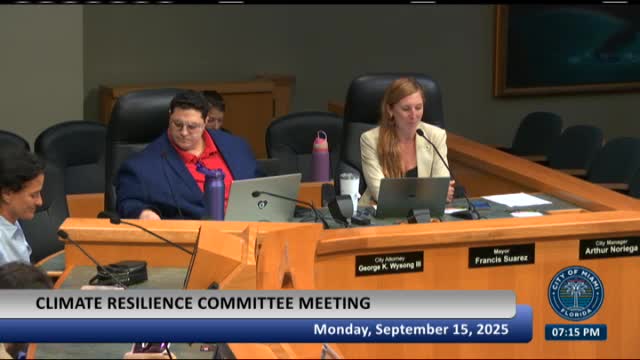City Completes Blue Street Project Enhancing Tree Coverage in Little Havana
September 15, 2025 | Miami, Miami-Dade County, Florida
This article was created by AI summarizing key points discussed. AI makes mistakes, so for full details and context, please refer to the video of the full meeting. Please report any errors so we can fix them. Report an error »

The City of Miami's Climate Resilience Committee recently convened to discuss significant advancements in local environmental initiatives, particularly focusing on the Blue Street project and the installation of heat sensors in homes. These efforts are part of a broader strategy to enhance urban resilience against climate change impacts.
The Blue Street project, located on Southwest Third Street near Jose Marti Park in the Little Havana pedestrian priority zone, has made substantial progress since its inception. The initiative aims to improve urban greenery and reduce flooding and heat in the area. According to city officials, the project has increased tree coverage by over 70%, adding approximately 20 new trees. The use of structural soil, porous concrete for sidewalks, and porous asphalt for parking spaces is expected to create a more walkable environment while mitigating the urban heat island effect.
Committee members expressed enthusiasm about the project's nearing completion, highlighting its potential to serve as a demonstration of effective climate resilience strategies. Although no photographs were available during the meeting, officials promised to share visuals in future updates.
In addition to the Blue Street project, the committee reported on the installation of 78 heat sensors in homes located in energy-burdened neighborhoods. This initiative aims to monitor temperature variations and provide data that can inform future energy efficiency programs and climate adaptation strategies.
Overall, the discussions at the Climate Resilience Committee meeting underscored the City of Miami's commitment to addressing climate challenges through innovative urban planning and community-focused projects. As these initiatives progress, they are expected to play a crucial role in enhancing the city's resilience to climate change while improving the quality of life for residents. Future meetings will likely continue to explore these themes and assess the effectiveness of ongoing projects.
The Blue Street project, located on Southwest Third Street near Jose Marti Park in the Little Havana pedestrian priority zone, has made substantial progress since its inception. The initiative aims to improve urban greenery and reduce flooding and heat in the area. According to city officials, the project has increased tree coverage by over 70%, adding approximately 20 new trees. The use of structural soil, porous concrete for sidewalks, and porous asphalt for parking spaces is expected to create a more walkable environment while mitigating the urban heat island effect.
Committee members expressed enthusiasm about the project's nearing completion, highlighting its potential to serve as a demonstration of effective climate resilience strategies. Although no photographs were available during the meeting, officials promised to share visuals in future updates.
In addition to the Blue Street project, the committee reported on the installation of 78 heat sensors in homes located in energy-burdened neighborhoods. This initiative aims to monitor temperature variations and provide data that can inform future energy efficiency programs and climate adaptation strategies.
Overall, the discussions at the Climate Resilience Committee meeting underscored the City of Miami's commitment to addressing climate challenges through innovative urban planning and community-focused projects. As these initiatives progress, they are expected to play a crucial role in enhancing the city's resilience to climate change while improving the quality of life for residents. Future meetings will likely continue to explore these themes and assess the effectiveness of ongoing projects.
View full meeting
This article is based on a recent meeting—watch the full video and explore the complete transcript for deeper insights into the discussion.
View full meeting